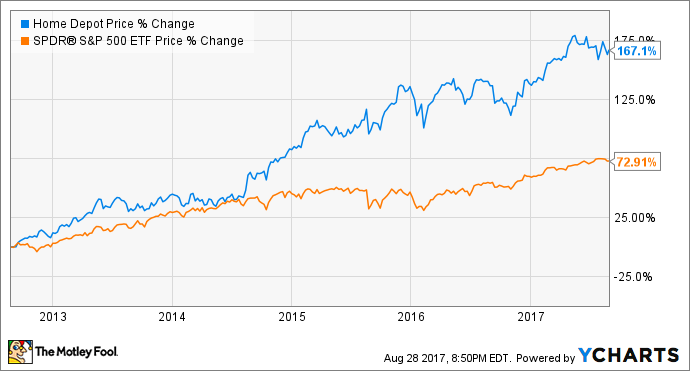Longtime Home Depot (HD -1.77%) investors can be forgiven if they are a bit spoiled. After all, it's hard to pick a time frame in which the stock price hasn't trounced the market. Over the past five years, shares have increased over 150%, while the S&P 500 has failed to put up even half those gains. Go back ten years or even further and that gap only widens.
Like any successful business, Home Depot has had to find new ways to continue to stay ahead of competitors like Lowe's Companies. And in recent quarters, the company has consistently highlighted three major objectives: 1) refining the customers' interconnected experience by seamlessly blending the digital and physical retail worlds; 2) launching innovative and exclusive home improvement products; and 3) increasing the efficiency of its supply chain. Let's take a closer look at each of these to better understand what's driving this business.
Data by YCharts.
Not a house divided
In the second quarter, Home Depot's e-commerce represented 6.4% of sales and increased 23% year over year. This is one of the few companies that understands that today's retail landscape requires more than just a robust online sales platform to beat the likes of Amazon.com -- it also requires a holistic shopping experience. In the second-quarter's conference call, CEO Craig Menear put it this way:
In many, many categories, the shopping experience starts in the digital world, even though it might finish in the physical world or in some cases, actually finish in the digital world as well. It is truly a blended experience today where the customer, the front door of our store is no longer at the front door of our physical store for many, many product categories. The customer starts digitally, looking at products, doing research. And then, in many cases, particularly in large ticket, they come in and they actually want to talk to one of our associates before they make a purchase.
During the same conference call, CFO Carol Tome added, "This is One Home Depot, not an online or on in-store business, but its One Home Depot." The blending of the digital and physical retail experience is evident in many aspects of the business. For starters, 43% of online orders are picked up in the store. In the first quarter conference call, management boasted that its updated online checkout process reduced customer checkout times by 20%. And Home Depot is now leveraging the data it has on its customers by targeting ads and personalizing their app home pages based on location and past shopping patterns.

Home Depot has revamped its website and app, launched exclusive products, and increased its supply chain efficiency. Image source: Getty Images.
Only at Home Depot
Another way Home Depot fends off competition is by launching exclusive products. They range from small ticket items to much larger purchases. For instance, management said it's selling exclusive organic mulch to customers for four times the cost of standard mulch. On larger ticket items, the company offers products like improved vinyl plank flooring with a PVC core making it lightweight, easy to install, and strong and rigid. Other exclusive products include best-selling, brand name cordless and gas mowers.
Of course, the company knows that offering this continuing parade of products requires close cooperation with its supply partners. Home Depot says it manages this by ensuring high-volume sales for exclusive product launches. It's hard for competitors to encroach on Home Depot's market share when consumers can't shop anywhere else for the products they want.
Doing its homework
According to management, Home Depot has made incredible strides in improving the productivity of its supply chain, especially in delivery and receiving in the back end of its stores. Earlier this year at an industry conference, Edward Decker, the Executive VP of Merchandising, said:
... [Y]ou've heard us talk about our Supply Chain Synchronization ... it's a multiyear journey for us to ultimately do joint business planning with our supplier base, joint forecasting, order expectations and timing, synchronized transportation, synchronized flow of product into the store to the shelf and having that just one seamless, end-to-end supply chain.
According to Decker, this focus on increasing efficiencies improves the on-shelf availability of products and reduces costs, something the company's suppliers also benefit from. This focus has led the company to change the way it loads its tractor trailers, so it now only requires two trucks for every three it needed previously. The company also provides explicit instructions to employees unloading the trucks at stores, including provision of a map of each truck's supplies and instructions telling employees where to stand around the conveyor belt.
Home sweet home
No investor can reliably predict what a stock is going to do the next day, the next month, or even the next year. That's why Foolish investors know it wise to focus on long term stories where eventually, a business' fundamentals will dictate its success and share price performance. As long as the company continues to execute on these three crucial objectives, investors should continue to be rewarded for holding this stock for years to come.






